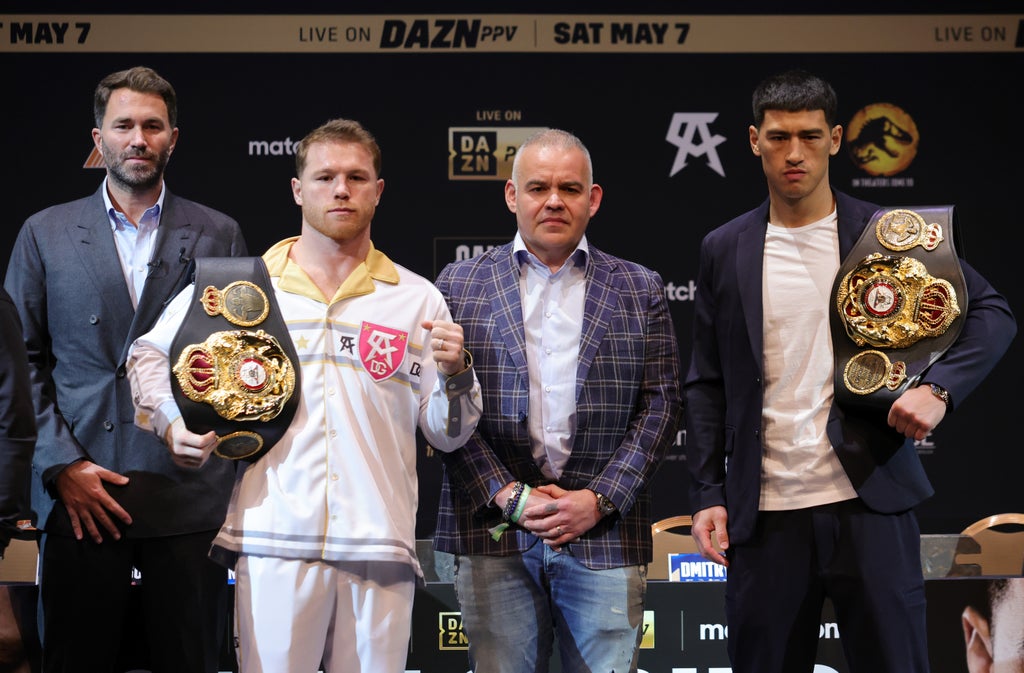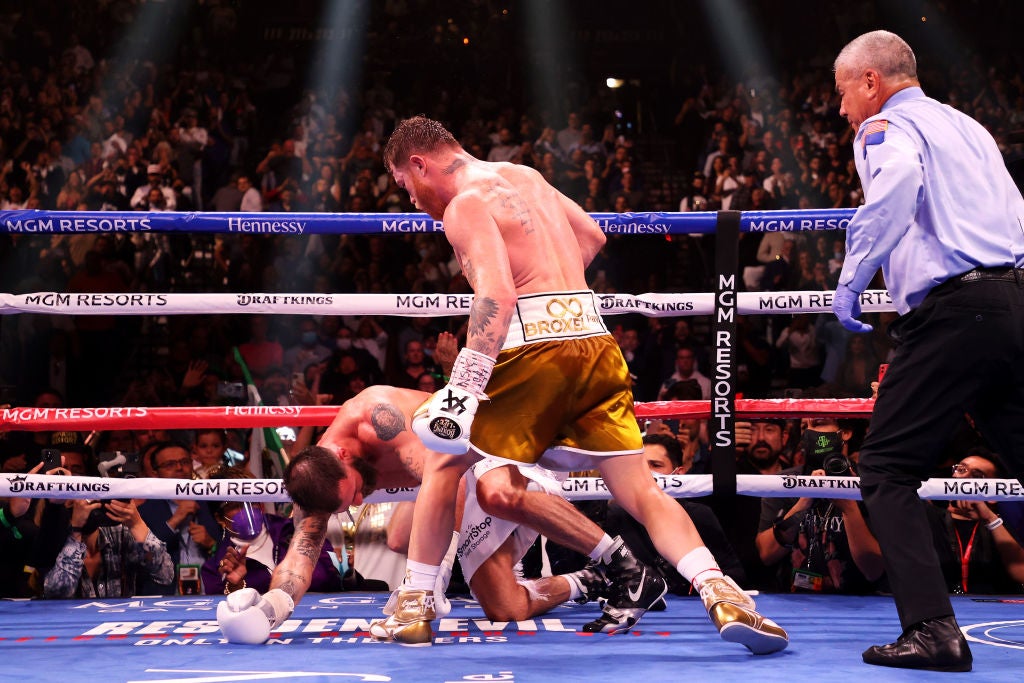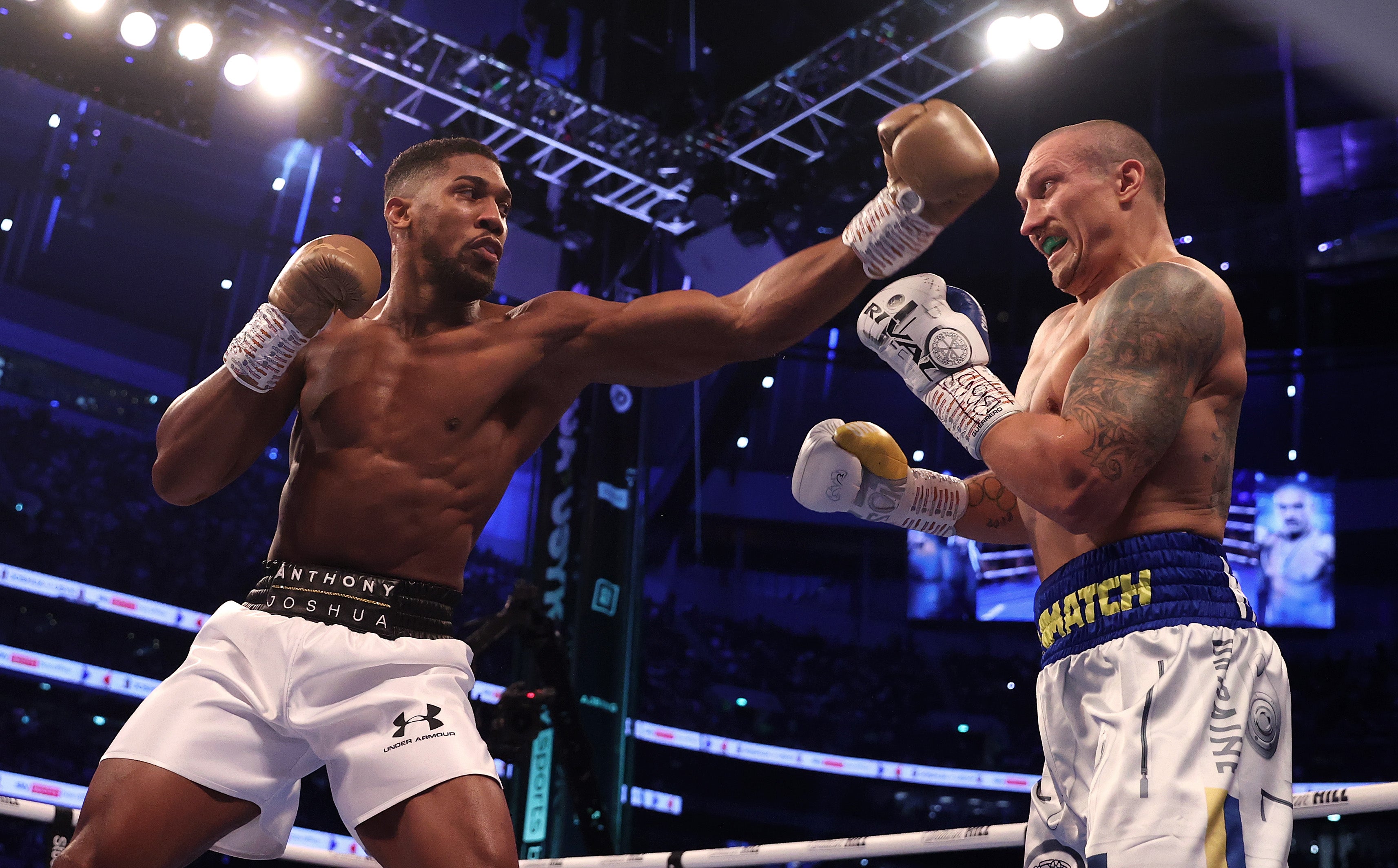
On Saturday night in Las Vegas, shortly after 8pm local time, Saul “Canelo” Alvarez will lock eyes with Dmitry Bivol.
In the 47 minutes that follow, should the fight go to the judges’ scorecards, any distance between the respective boxing abilities of the combatants will be revealed.
In those initial moments, though, when the pair touch gloves under the T-Mobile Arena lights, there will be very little separating them.
What is crucial for Canelo is that, when he locks eyes with Bivol, his gaze remains fixed. Because, days out from his clash with the WBA light-heavyweight champion, it appears the Mexican already has his eyes on bigger bouts.
In fairness to Canelo, that seems to have been a perennial state for the ambitious boxer over the last nine years. Since his sole professional loss – a decision defeat by Floyd Mayweather in 2013 – 12 of his 16 fights have been world title fights; only two of them have been defences.
Canelo, now 31, has spent the best part of the last decade venturing to new kingdoms and collecting crowns. Most recently, the Mexican dethroned Caleb Plant to take the IBF super-middleweight title. In doing so, he became the division’s first ever undisputed champion in the four-belt era, and the first undisputed title holder in his nation’s history.
Canelo, who has also held belts at light-middleweight, middleweight and light-heavyweight, continues to assert his status as boxing’s pound-for-pound king, and he will return to light-heavyweight this weekend.

Alvarez, who took the WBO title from Sergey Kovalev in 2019, will look to add the WBA belt to the long list of jewels that he has acquired over the years. To do that, he must hand Bivol the first loss of the Russian’s professional career.
If Canelo succeeds, a trilogy bout with old rival Gennady Golovkin awaits.
The Kazakh was denied a victory over Alvarez in their first meeting, in 2017, when the pair fought to a controversial draw. In their rematch the following year, a modern classic, Canelo was awarded the win. After the closest of contests, there was still controversy around the scorecards. Golovkin, as great as he is, seems unable to knock out his foe. The judges, meanwhile, seem unable to stop Canelo either.
Furthermore, Golovkin has just turned 40. There is a risk that the IBF, IBO and WBA middleweight champion’s punch resistance has deteriorated just enough to enable Canelo to put him down – for what would be the first time in GGG’s career. There is a risk, in fact, that Golovkin will emerge from this rivalry without an official win, and that revisionists will deny him the credit he has earned.
Whatever the Kazakh’s fate, Canelo is already looking through Golovkin. That is not to say Canelo is looking past him, but the king has his sights set on yet another kingdom to conquer.
The Mexican’s intriguing target? Oleksandr Usyk.
Usyk’s accolades are plentiful. The Ukrainian is unbeaten as a pro, he is an Olympic gold medalist and former undisputed cruiserweight champion. Now the 35-year-old holds the WBA, WBO, IBF and IBO heavyweight titles, having forcefully taken them from Anthony Joshua in the Briton’s own backyard last September.
The pair are set for a rematch this July, and the winner will be expected to unify the belts with Tyson Fury if the WBC champion decides to keep fighting.

As a result, it is unclear when there would be space for Canelo to face Usyk. Furthermore, if the Ukrainian is to lose to Joshua, this would seem not to be a situation in which one opponent could simply be swapped out for another; Usyk’s candidacy for a clash with Canelo seems in large part linked to his cruiserweight past.
Eddie Hearn, who coincidentally promotes Joshua and – at times, such as this Saturday – Canelo, told JOE this week: “When we talk about mindset and winning, [Alvarez] genuinely believes he can beat Oleksandr Usyk for the world heavyweight title.
“He said to me: ‘If you can make that fight at one pound above cruiserweight – which obviously... Usyk was a cruiserweight – I will beat him.’”
Indeed, for Canelo to leap up two weight classes beyond his current upper limit would seem too much even for the pound-for-pound No 1.
Usyk, a southpaw, is seven inches taller than Canelo with a reach advantage of seven-and-a-half inches. There is no doubting that the Ukrainian has a power advantage, and he has the volume to match Canelo. Usyk has also shown his resilience, having taken significant shots from Joshua and a few against Derek Chisora.
“Sometimes,” Hearn added, “the only way someone like Canelo Alvarez or Vasyl Lomachenko gets beat is when they keep moving up in weight – outside of where they should be.
“That’s maybe how Canelo Alvarez gets beat, [if] it’s a challenge too far.”

Usyk may indeed prove to be a challenge too great for Canelo, whose ambition should nevertheless be admired. At the moment, the heavyweight champion is at least two challenges away.
Canelo must first maintain focus and navigate the challenge presented by Bivol, who is quick and aggressive but not the most inventive opponent the Mexican has faced.
If Canelo is successful on Saturday, he must then close the door on his rivalry with Golovkin. If he can do so, there is even the prospect of a meeting with Artur Beterbiev – the unbeaten but aging WBC and IBF light-heavyweight champion.
For now, Canelo vs Usyk is little more than a fascinating prospect bound to hypotheses.
By the end of the weekend, it might just have evolved into something more.







